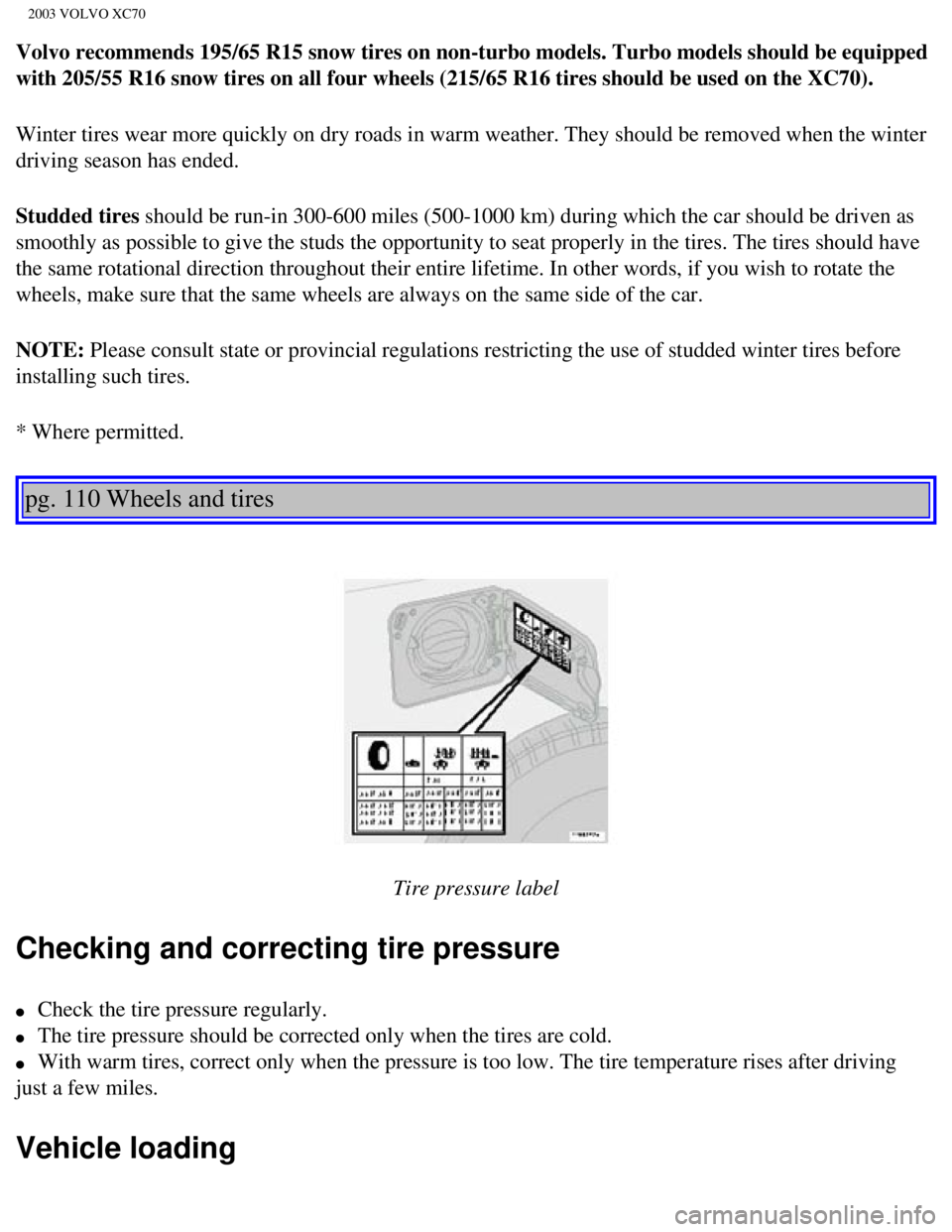Page 157 of 257

2003 VOLVO XC70
four wheels. When replacing tires, be sure that the new tires are the same dimensio\
ns, type (radial) and
preferably from the same manufacturer, on all four wheels. Do not use bi\
as ply tires. Otherwise there is a
risk of altering the car's roadholding and handling characteristics.
NOTE: When storing wheel/tire assemblies (e.g. snow tires and wheels), eith\
er stand the assemblies
upright, or suspend them off the ground. Laying wheel/tire assemblies on\
their sides for prolonged
periods can cause wheel and/or tire damage.
Wear indicator
The tires have wear indicator strips running across or parallel to the t\
read. When approx. 1/16" (1.6 mm)
is left on the tread, these strips become visible and indicate that the \
tire should be replaced.
Tires with less than 1/16" (1.6 mm) tread have very poor grip in rain \
or snow.
To improve tire economy:
l Maintain correct tire pressure. See the tire pressure label on the insid\
e of the fuel filler door.
l Drive smoothly: avoid fast starts, hard braking and tire screeching.
l Tire wear increases with speed.
l Correct front wheel alignment is very important.
l Unbalanced wheels impair tire economy and driving comfort.
l Volvo does not recommend rotating the tires. However, if tires are rotat\
ed, they must be kept on the
same side of the car so that they revolve in the same direction as befor\
e rotation.
l Hitting curbs or potholes can damage the tires and/or wheels permanently\
.
Flat spots
All tires become warm during use. After cooling, when the vehicle is par\
ked, the tires have a tendency to
distort slightly, forming flat spots. These flat spots can cause vibrati\
ons similar to the vibrations caused
by unbalanced wheels. They do, however, disappear when the tire warms up\
. The degree to which flat
spots form depends on the type of cord used in the tire. Remember that, \
in cold weather, it takes longer
for the tire to warm up and consequently longer for the flat spot to dis\
appear.
CAUTION: The car must not be driven with wheels of different dimensions/specific\
ations or with a
spare tire other than the one that came with the car. The use of differe\
nt size wheels can seriously
damage your car's transmission or driveline.
pg. 109 Wheels and tires
file:///K|/ownersdocs/2003/2003_XC70/03xc70_07.htm (2 of 10)12/30/2006\
4:18:01 PM
Page 158 of 257

2003 VOLVO XC70
Snow chains
Snow chains can be used on your Volvo with the following restrictions:
l Snow chains should be installed on front wheels only. Use only Volvo app\
roved snow chains.
l Special snow chains must be mounted on 215/55 R16. Consult your Volvo re\
tailer.
l If accessory, aftermarket or "custom" tires and wheels are installed and\
are of a size different than the
original tires and wheels, chains in some cases CANNOT be used. Sufficie\
nt clearances between chains
and brakes, suspension and body components must be maintained. Snow chai\
ns cannot be used on 17"
wheels.
l Some strap-on type chains will interfere with brake components and there\
fore CANNOT be used.
l All Wheel Drive models:Snow chains should only be installed on the front wheels. Only chains
adapted for AWD models should be used.
Consult your Volvo retailer for additional snow chain information.
CAUTION:
l Check local regulations regarding the use of snow chains before installi\
ng.
l Always follow the chain manufacturer's installation instructions careful\
ly. Install chains as tightly as
possible and retighten periodically.
l Never exceed the chain manufacturer's specified maximum speed limit. In \
no case should you exceed
31 mph (50 km/h).
l Avoid bumps, holes or sharp turns when driving with snow chains.
l Vehicle handling can be adversely affected when driving with chains. Avo\
id fast maneuvering and
hard braking. Never allow the wheels to lock up during braking.
Snow tires, studded tires *
Tires for winter use:
Owners who live in or regularly travel through areas with sustained peri\
ods of snow or icy driving
conditions are strongly advised to fit suitable winter tires to help ret\
ain the highest degree of
traction. It is important to install winter tires on all four wheels to help retain traction during cornering,
braking, and accelerating. Failure to do so could reduce traction to an \
unsafe level or adversely affect
handling. Volvo does not recommend tire rotation. However, as with any o\
ther radial tires, if rotated, the
tires must be kept on the same side of the car so that they revolve in t\
he same direction as before
rotation.
file:///K|/ownersdocs/2003/2003_XC70/03xc70_07.htm (3 of 10)12/30/2006\
4:18:01 PM
Page 159 of 257

2003 VOLVO XC70
Volvo recommends 195/65 R15 snow tires on non-turbo models. Turbo models\
should be equipped
with 205/55 R16 snow tires on all four wheels (215/65 R16 tires should \
be used on the XC70).
Winter tires wear more quickly on dry roads in warm weather. They should\
be removed when the winter
driving season has ended.
Studded tires should be run-in 300-600 miles (500-1000 km) during which the car shou\
ld be driven as
smoothly as possible to give the studs the opportunity to seat properly \
in the tires. The tires should have
the same rotational direction throughout their entire lifetime. In other\
words, if you wish to rotate the
wheels, make sure that the same wheels are always on the same side of th\
e car.
NOTE: Please consult state or provincial regulations restricting the use of st\
udded winter tires before
installing such tires.
* Where permitted.
pg. 110 Wheels and tires
Tire pressure label
Checking and correcting tire pressure
l Check the tire pressure regularly.
l The tire pressure should be corrected only when the tires are cold.
l With warm tires, correct only when the pressure is too low. The tire tem\
perature rises after driving
just a few miles.
Vehicle loading
file:///K|/ownersdocs/2003/2003_XC70/03xc70_07.htm (4 of 10)12/30/2006\
4:18:01 PM